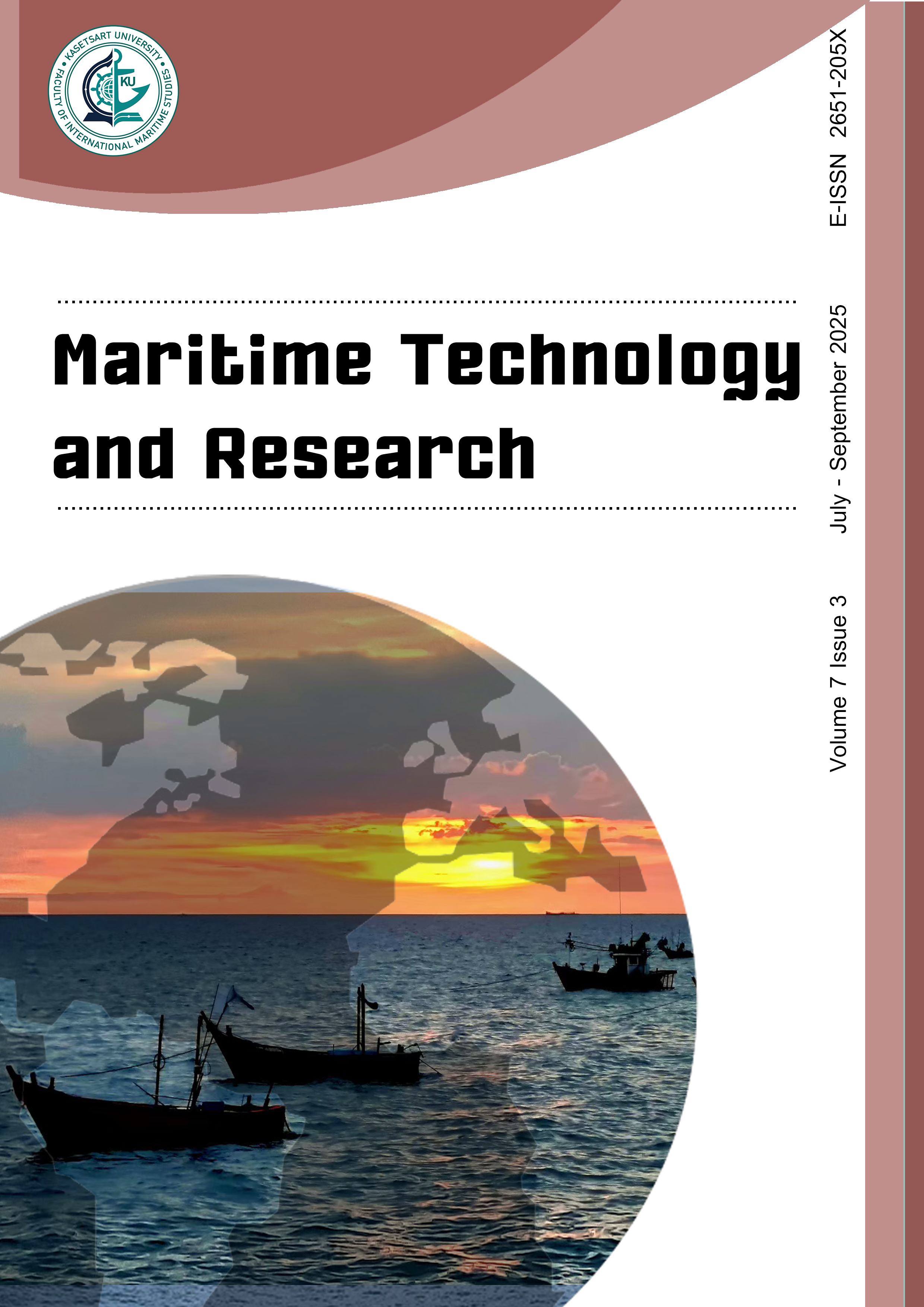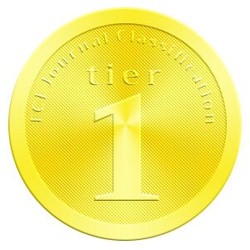Weighting the factors affecting safety of navigation: A case study for the Gulf of İzmit, Türkiye
DOI:
https://doi.org/10.33175/mtr.2025.274135Keywords:
Gulf of İzmit; Analytic Hierarchy Process; Safety of navigation; Cargo transportation; Vessel traffic; Local trafficAbstract
Cargo transportation is globally carried by sea. The increasing population and associated needs increase the amount and diversity of cargo transported by vessels. The tonnage and number of vessels are also increasing accordingly. Although production and storage points are established in the regions where raw materials are located, they are concentrated in coastal areas in accordance with intermodal transportation. The Gulf of Izmit is the maritime region with the largest maritime facilities in Türkiye due to its location within the Turkish Straits, its dense population, its proximity to production and raw materials, and its strategic location where transportation modes intersect. Vessel Traffic, Pilotage, and Tugboat Services units operate in the region in order to increase the safety of navigation. However, many factors, such as geographical, meteorological, and hydrographic conditions of the region, and critical structures, local traffic, fishing activities, and the presence of dangerous cargo terminals, affect the safety of navigation. In this study, it was decided to use the Analytic Hierarchy Process (AHP) method, one of the Multi-Criteria Decision Making (MCDM) techniques, to identify the factors affecting navigational safety in Gulf of Izmit, to rank them in order of importance and to determine the measures to be taken. In this context, firstly, an extensive literature review was conducted. The data obtained were analyzed by 10 people who are experts in their fields, have academic backgrounds, and work in the region as pilots, vessel traffic operators, port state control officers, and oceangoing masters. Dynamic (variable) and static (unchangeable) risks in the region were identified and a hierarchical structure was obtained. The weights of the factors within the hierarchical structure were determined by making numerical comparisons with each other and the importance ranking was revealed.
------------------------------------------------------------------------------
Cite this article:
Dağkıran, B., Bolat, P. (2025). Weighting the factors affecting safety of navigation: A case study for the Gulf of İzmit, Türkiye. Maritime Technology and Research, 7(3), 274135. https://doi.org/10.33175/mtr.2025.274135
------------------------------------------------------------------------------
Highlights
- Navigational risks in Gulf of Izmit have been identified in detail and ranked in order of importance.
- Vessel traffic, pilotage and escort services are critical and must be improved to reduce navigational risks.
- Local traffic, sub-standard vessels and seafarers pose a risk and must be addressed by the public authority.
References
Afonin, A. (2018). A comprehensive assessment of the safety of navigation in the water area of the Northern Sea Route. The Government Decree of the Russian Federation.
Akyüz, E. (2015). A decision-making model proposal on human reliability analysis on-board ships (Ph.D. Thesis). İstanbul Technical University, İstanbul.
Anıker, A. T. (2022). Genel Römorkör Refakat Emniyet Uygulamaları ve İzmit Körfezi. Retrieved from https://www.denizhaber.com/genel-romorkor-refakat-emniyet-uygulamalari-ve-izmit-korfezi
Aydın, Y. (2017). Investigation of negative impacts increasing vessel traffic in the gulf of İzmit (Master Thesis). Piri Reis University, İstanbul, Turkey.
Baig, M. Z., Lagdami, K., & Mejia Jr, M. Q. (2024). Enhancing maritime safety: A comprehensive review of challenges and opportunities in the domestic ferry sector. Maritime Technology and Research, 6(3), 268911. https://doi.org/10.33175/mtr.2024.268911
Bolat, P., Kayişoğlu, G., Güneş, E., Kızılay F. E., & Özsöğüt, S. (2020). Weighting key factors for port congestion by AHP method. Journal of ETA Maritime Science, 8(4), 252-273. https://dx.doi.org/10.5505/jems.2020.64426
Breedveld, D. (1999). Waypoint navigation for rivercraft?, The Journal of Navigation, 52(1), 136-138. https://doi.org/10.1017/S0373463398008194
Chamber of Shipping. (2023). Maritime activity report. Chamber of Shipping (İMEAK), İstanbul, Turkey.
Canımoğlu, R., Yıldırım, U., & İnegöl, G.M. (2021). Analysis of draught survey errors by extended fuzzy analytic hierarchy process. Journal of ETA Maritime Science, 9, 51-63. https://doi.org/10.4274/jems.2021.64872
Cil, I., Arisoy, F., Özgürbüz, E., Cil, A. Y., & Kılınç, H. (2022). Indoor positioning technology selection using a combined AHP and PROMETHEE method at SEDEF Shipyard. Journal of ETA Maritime Science, 10(2), 108-123. https://doi.org/10.4274/jems.2022.47550
Dalaklis, D., Katsoulis, G., Kitada, M., Schröder-Hinrichs, J. U., & Ölcer, A. I. (2020). A “Net-Centric” conduct of navigation and ship management. Maritime Technology and Research, 2(2), 90-107. https://doi.org/10.33175/mtr.2020.227028
Dönmez, Y., & Güngördü, M. (1985). Climate and vegetation characteristics of the Gulf of İzmit, Journal of Geography, 1, 143.
Gao, Y., Gan, X., & Ai, W. (2019). Analysis of factors affecting safety navigation of inland river bending channel. Engineering and Technology Research. https://doi.org/10.12783/DTETR/ICAEN201/29038
Garipağaoğlu, N., & Uzun, S. M. (2014). The usage of coastal araea in the coasts of Gulf of İzmit. Turkish Geographical Society, 63, 9-22. https://doi.org/10.17211/tcd.21868
General Directorate of Coastal Safety. (2024). İzmit Vessel Traffic Service Center. 2023 Annual Report, Kocaeli, Turkey.
General Directorate of Maritime Affairs. (2022). Bulletin of maritime statistics. Ankara. Retrieved from https://denizcilik.uab.gov.tr/uploads/pages/yayinlar/denizcilik-istatistikleri-bulteni- 2022-04-02-2023.pdf
General Directorate of Maritime Affairs. (2023a) Maritime statistics. Ankara. Retrieved from https://denizcilikistatistikleri.uab.gov.tr/gemi-istatistikleri
General Directorate of Maritime Affairs. (2023b). Maritime statistics. Ankara. Retrieved from https://denizcilikistatistikleri.uab.gov.tr/yuk-istatistikleri
General Directorate of Maritime Affairs. (2023c). Maritime statistics. Ankara. Retrieved from https://denizcilikistatistikleri.uab.gov.tr/kabotaj-hatti-istatistikleri
Gucma, S., Ślączka, W., & Bąk, A. (2022). Assessment of ship manoeuvring safety in waterway systems by relative navigational risk. Archives of Transport, 64(4), 119-134. https://doi.org/10.5604/01.3001.0016.1230
Hasanspahić, N., Frančić, V., Rudan, I., & Maglić, L. (2018). Analysis of navigation safety regarding tankers in narrow waterways. Journal of Maritime & Transportation Sciences, 55(1), 201-217. https://doi.org/10.18048/2018.00.13
Hergüner, M. (2015). Kocaeli port authority in historical development. In Proceedings of the National Port Congress, İzmir, Turkey.
IALA. (2014). Gulf of İzmit Ports and waterways safety assessment workshop report. International Association of Marine Aids to Navigation and Lighthouse Authorities (IALA). İstanbul, Turkey.
Landgeist. (2023). Europe’s 100 busiest cargo ports. Retrieved from https://landgeist.com/2023/08/29/europes-100-busiest-cargo-ports
Li, H., Hu, Q., & Zhang, Q. (2013). Establishment of navigation environment safety index of changjiang river based on Bayesian Network with GeNIe. In Proceedings of the Improving Multimodal Transportation Systems-Information, Safety, and Integration. Wuhan, China. https://doi.org/10.1061/9780784413036.031
Li, H., & Zhang, Y. (2011). Research on the safety assessment of navigation conditions near bridge waters based on fuzzy theory. In Proceedings of the 11th International Conference of Chinese Transportation Professionals. Nanjing, China. https://doi.org/10.1061/41186(421)387
Liu, J., Liu, Z., & Wang, Y. (2011). Evaluation of navigation safety of port waters based on SPA. In Proceedings of the 11th International Conference of Chinese Transportation Professionals. Nanjing, China. https://doi.org/10.1061/41177(415)298
Nwokedi, T. C., Akpufu, I.D., Ndikom, O.B., Mbachu, J.C., Anyanwu, C.E., & Daniel, B.O. (2022). Periscoping performance of classification societies in maritime safety from the prism of the Abuja MoU on port states control. Maritime Technology and Research, 5(2). https://doi.org/10.33175/mtr.2023.260788
Özbek, A., & Eren, T. (2013). Selecting of third party logistics (3PL) firm through the analytic hierarchy process (AHP). International Journal of Engineering Research and Development, 5(2), 46-54.
Özdemir, Ü. (2016). Investigation of occupational accidents occurred in ports by using fuzzy DEMATEL and fuzzy TOPSIS methods. Journal of ETA Maritime Science, 4(3), 235-247. https://doi.org/10.5505/jems.2016.74936
Park, J., & Yea, B. (2008). A study on the influence of navigational environment on mariner’s behavior for collision avoidance. Journal of Navigation and Port Research, 32(2), 127-132. https://doi.org/10.5394/KINPR.2008.32.2.127
Pham, Y. T, Truong, N. C., Nguyen, P. H., & Kim, H. (2024). Decision-making for shipping networks based on adaptive cumulative prospect theory: A case study in Vietnam. Journal of ETA Maritime Science, 12(2), 169-185. https://doi.org/10.4274/jems.2024.76993
Saaty, T. L. (2008). Decision making with the analytic hierarchy process. International Journal of Services Sciences, 1(1), 83-98. https://doi.org/10.1504/IJSSCI.2008.017590
Shipbuilding Industrialists’ Association. (2022). Shipbuilding, maintenance and repair sector 2021-2022 statistical data report. Shipbuilding Industrialists’ Association (GİSBİR), İstanbul, Turkey.
Singh, A., Dalaklis, D., & Baumler, R. (2023). Revisiting the HNoMS helge ıngstad and sola TS collision: Discussing the contribution of human factors. Maritime Technology and Research, 5(3), 262199. https://doi.org/10.33175/mtr.2023.262199
Sipahioğlu, A. (2008). Analytic hierarchy process (AHP) lecture notes. Department of Industrial Engineering, Osman Gazi University, Eskişehir, Turkey.
Şahin, O. A. (2015). Investigation of the Gulf of İzmit vessel traffic using IWRAP model (Master Thesis). İstanbul Technical University, İstanbul, Turkey.
Tunçel, A. L., Arslan, Ö., & Akyüz, E. (2023). An application of fuzzy AHP using quadratic mean method: Case study of ENC preparation process for ıntended voyages. Journal of ETA Maritime Science, 11(1), 56-66. https://doi.org/10.4274/jems.2023.05902
Turkish Port Operators’ Association. (2023). Türkiye port sector report. Turkish Port Operators’ Association (TÜRKLİM), Istanbul, Turkey.
Tzeng, G. H., & Huang, J. J. (2011). Analytic hiyerarchy process: Multiple attribute decision making: Methods and applications (pp. 15-27). Florida, US, CRC Press.
Tian, J., & Yan, Z. F. (2013). Fuzzy analytic hierarchy process for risk assessment to general assembling of satellite. Journal of Applied Research and Technology, 11, 568- 577. https://doi.org/10.1016/S1665-6423(13)71564-5
Vidan, P., Grzadziela, A., & Bosnjak, Z. (2012). Proposal of measures for increasing the safety level of inland navigation. Transactions on Maritime Science, 1(2), 85-88. https://doi.org/10.7225/toms.v01.n02.003
Yurtören, C., Aydoğdu, Y. V., Seta, H., & Atasoy, C. (2014). Analysis of the Gulf of İzmit vessel traffic flow (pp. 145-150). In Proceedings of the 1st National Vessel Traffic Services Congress, İstanbul, Turkey.
Yurtören, C., Aydoğdu, Y. V., Park, J., & Park, Y. (2012). A study on local traffic management to improve marine traffic safety in the Istanbul strait. Journal of Navigation, 65(1), 99-112. https://doi.org/10.1017/S0373463311000555
Downloads
Published
Issue
Section
Categories
License
Copyright (c) 2024 Maritime Technology and Research

This work is licensed under a Creative Commons Attribution-NonCommercial-NoDerivatives 4.0 International License.
Copyright: CC BY-NC-ND 4.0








